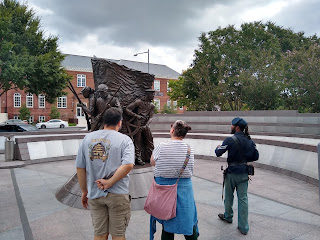 |
| In contrast to 2013, Washington's Stanton Park remains open |
|
|
|
|
|
|
|
|
|
|
|
|
|
|
|
|
DISCLAIMER: Also in contrast to 2013, I now have a son who works for a federal contractor. So this has become personal!
Ten years ago, I wrote two posts about the U.S. government shutdown, one about the difficulty of knowing when essential conversations about our common life are open and fair to all, and the other a pictorial reflection about being in Washington during the early days of the shutdown. "Some people," said a mother to her daughter explaining why there was a wee fence around Stanton Park, "are being sillypants."
That little girl must be 12 or 13 now, and presumably maturing in an age-appropriate way. That is less clear for congressional Republicans. This week I returned to Washington during another game of congressional chicken over federal budgeting. (I'm not ambulance chasing--really! Both years I was representing Coe College at the October meeting of Capitol Hill Internship Program advisers.) As it happened, the threat of a shutdown seems to have been averted Saturday, or at least postponed for 45 days, and anyhow my trip this year would have occurred too early for another round of shutdown pictures.
Still, as close as we got to a shutdown, with the demolition derby that our national politics has become, occupied the thoughts of all of us who take government people. To paraphrase Lincoln, ours is a government of people, by people, for people--so it will never get things exactly right, it will always leave some if not everyone unsatisfied, and yet it matters a lot to the quality of our lives together. Government is not meant to be a plaything, or a weapon.
After our meeting, I went up to U Street NW clutching the invaluable Frommer's 24 Great Walks in Washington, D.C. [Wiley, 2009... this is walk #15]. Jazz great Duke Ellington (1899-1974 grew up here, and for decades it was a center of black culture, even after suffering much from the 1968 riots.
 |
"Community Rhythms" mural by Alfred J. Smith, U Street station
|
|
 |
| 13th St NW: Young Duke Ellington lived here |
|
 |
13th and T: Adult Duke Ellington stayed here
|
 |
11th and U: This club hosted the greats of 50s/60s jazz
|
There are other landmarks here as well, including a memorial to African-Americans who served in the Civil War that lists every known participant. There also was (on this day, anyway) a young man in a Civil War uniform, expounding considerably about the war and the memorial.
 |
10th and U: African-American Civil War Memorial
|
 |
| Names on the memorial |
|
|
 |
11th and U: Oldest black-owned bank in DC
|
U Street has gentrified a lot in recent years.
 |
Some of the multitude of new construction
|
While I'm normally rather sanguine about gentrification, which does bring wealth and racial integration to places, it's jarring to see it to such a degree in a neighborhood so closely identified with black history. At least that history is being preserved.
U Street, too, is Washington--a place that embodies America's ongoing efforts to build and rebuild the good life. Washington is more than the cartoonish caricature presented by so many politicians, like former U.S. Representative Rod Blum, who served Iowa for two terns in Congress, and who is probably best remembered for wanting to inflict a recession on Washington.
Once you get away from the Capitol and into the neighborhoods, though, you find Washington is full of people, a lot of whom work for or with the federal government, and who are trying, as we all are, to do their jobs.
 |
10th and U: This too is Washington
|















No comments:
Post a Comment